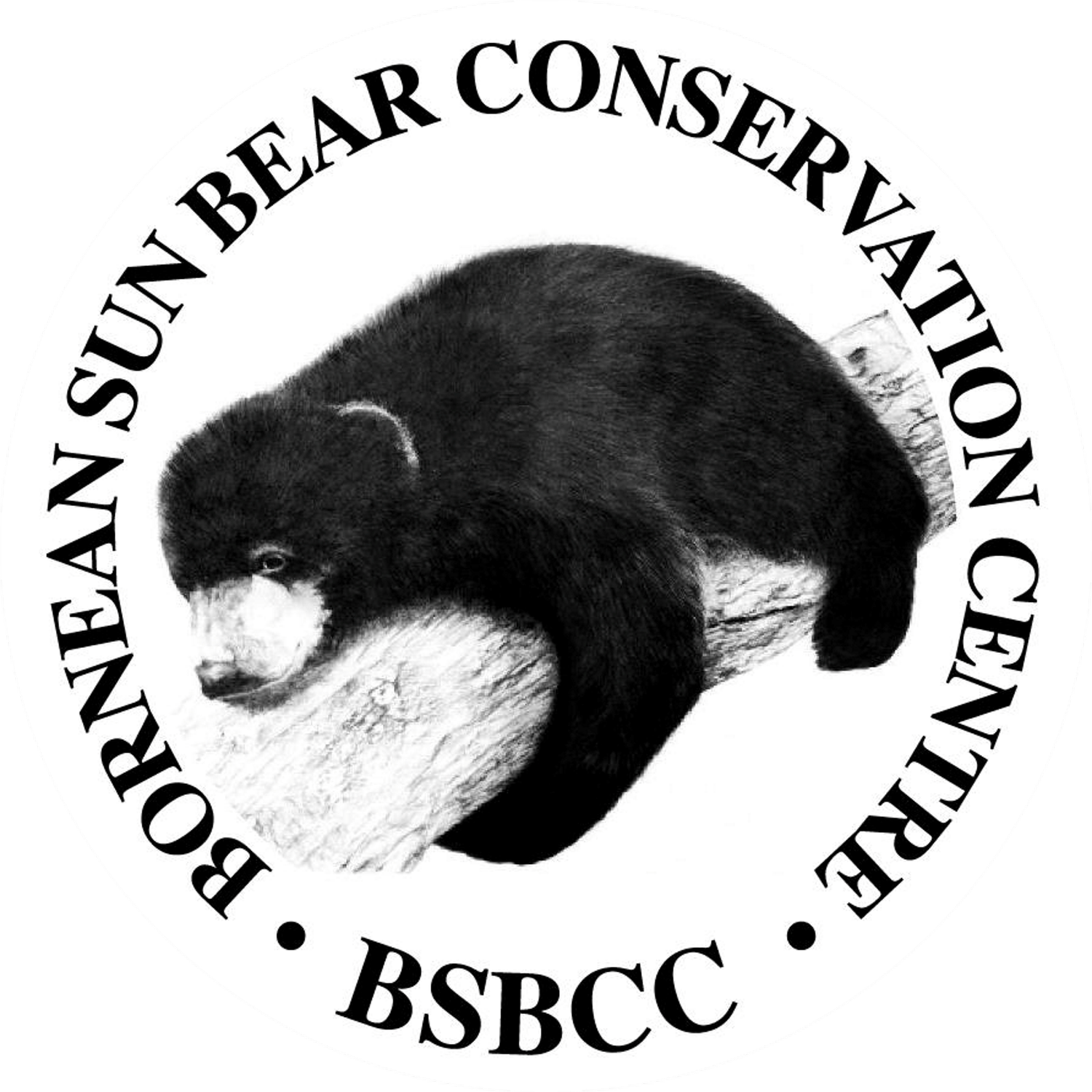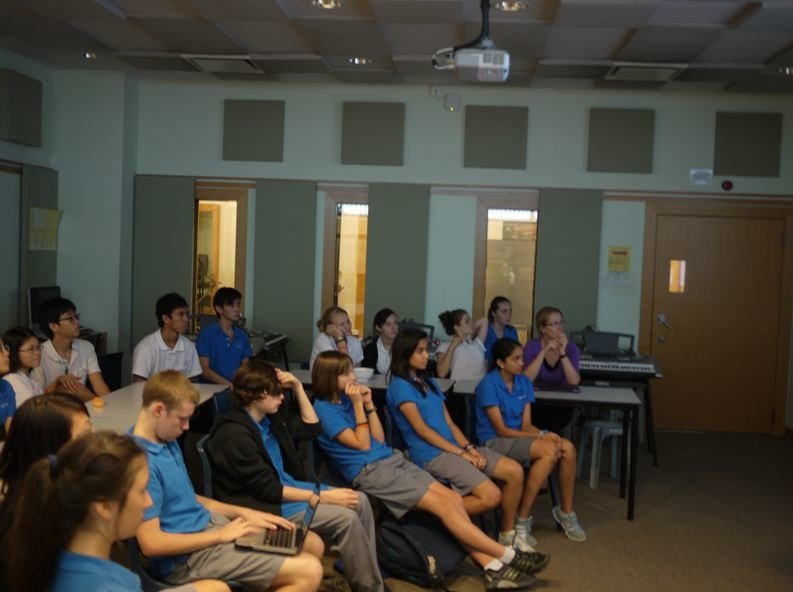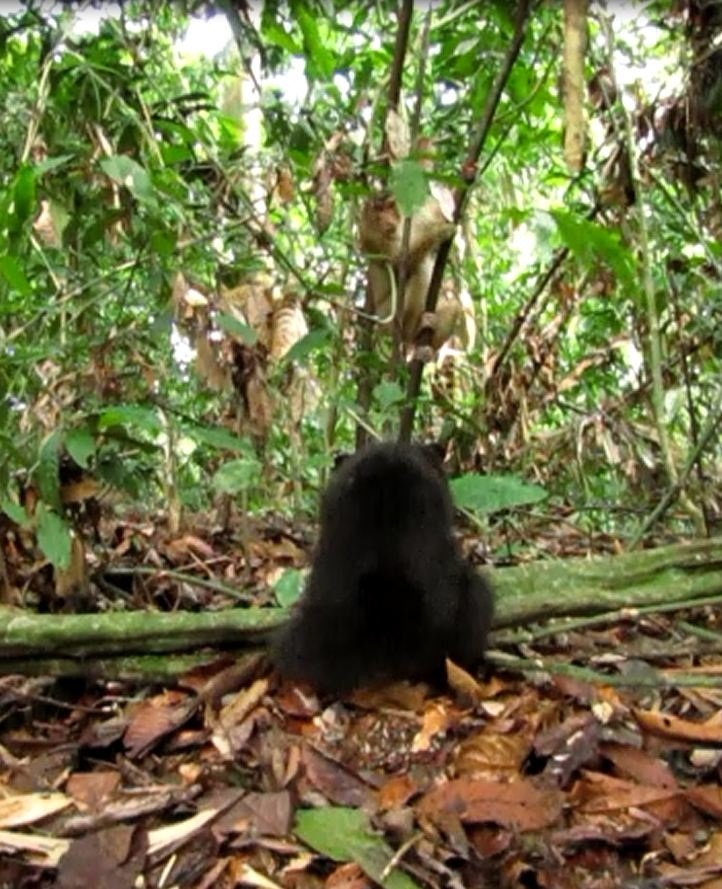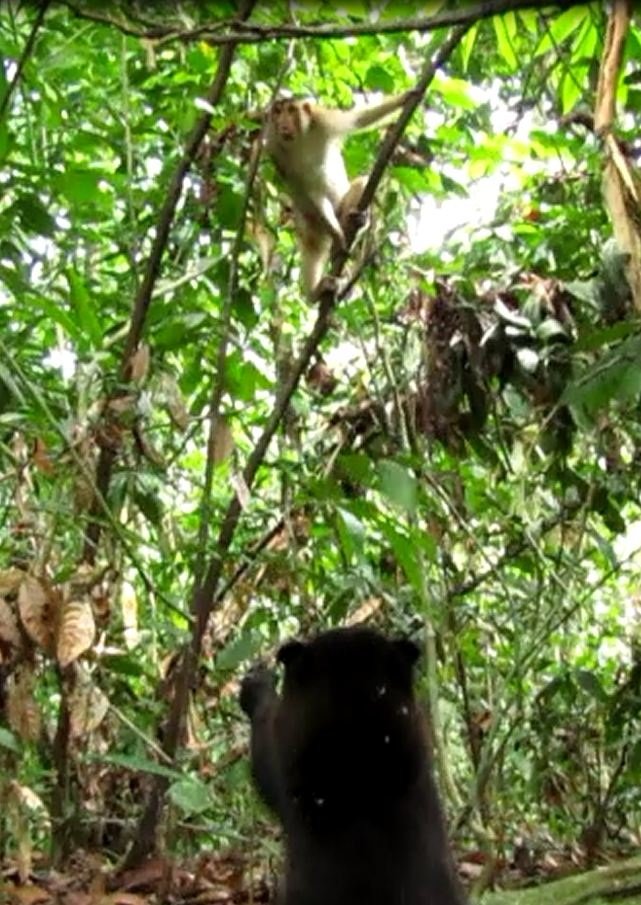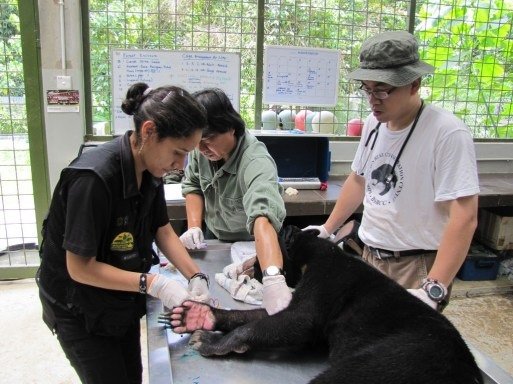The forgotten bears of S.E Asia – Presentation on Sun Bears @ UWC
It all begins with an idea.
Manis the Sun Bear at BSBCC.
In May/June 2010, 3 friends and I spent a total of 5 weeks at the Bornean Sun Bear Conservation Centre (BSBCC). The 4 of us were ex-colleagues at the Night Safari show department and were eager to put our husbandry and enrichment experiences to good use for the Sun Bears. Thanks to Mr Sivasothi, we were referred to Mr. Wong Siew Te, the founder of BSBCC.
Since returning from that internship, I have been sharing with people about the plight of Asia’s lesser-known bear species. My biology blog was initiated by that internship in Borneo. You can follow what went on during my internship here. In August 2010, I gave a presentation on the Sun Bears for a Toddycats Engage! meet-up session, a volunteer group from the Raffles Museum of Biodiversity Research, NUS. I also had the privilege of submitting an article to the Jakarta Globe in April 2011, discussing about the oil palm industry and their threat to wild life in Southeast Asia.
Me presenting to the students of United World College SEA.
Last week, I received a pleasant surprise in my email inbox. Sarah, a yoga instructor and mother of two boys who used to study at United World College (UWC), contacted me for help. She has never been to BSBCC but had come to know of Wong’s work through the internet. She had met someone in Singapore who spent a week or two at BSBCC and felt that it was important to spread the word here about the Sun Bears. She believes strongly in involving youths at such meaningful projects and wanted to help in any way that she could. Her sense of initiative was so strong that she had actually already created her own series of presentation slides based on information from the internet! I jumped at the opportunity to assist her.
Sarah, during her part of the presentation on how individuals can help, as well as appealing for BSBCC's current donations wish list
The audience were high school students from UWC’s Global Concerns Group (PAW: Promoting Animal Welfare). From their expressions, I could tell that they were amazed by these incredibly special bears, the most arboreal and illusive of all bear species. I answered some questions pertaining to how they could visit as volunteers and what the conservation centre was like.
Students and staff of UWC's Global Concerns Group; PAW:Promoting Animal Welfare.
It was indeed encouraging to know that youths are so eager to lend a helping land to these precious Sun Bears of Borneo. It is also amazing to see how social media platforms have extensively influenced people like Sarah to be so passionate about conservation. I hope to continue raising awareness for the interests of Borneo’s remaining Sun Bears.
Slowly but surely, the world will know about the sun bear!
It all begins with an idea.
Sun bear remains the least known bear species in the world. Not many people, locals, general public, and students included, from SE Asia know about there is a bear call sun bears that live in their own country. It is very sad if you think of it: a large carnivore that plays important roles in the forest ecosystem but are completely being forgotten. Sun bear is a charismatic large mammal but unfortunately most general public know more about foreign bear species, i.e., grizzly bear, giant panda, and polar bear, than a native bear species live in their own country.
However, this situation is changing after the establishment of Bornean Sun Bear Conservation Centre (BSBCC). Our blog at http://sunbears.wildlifedirect.org/ has been viewed 122, 006 times by 74,514 different people across the world since May 2010. At the same time, there are more and more people help us to spread the words and love about sun bears over the past three years. In the last few months, there were more books written about sun bears than the all books published in the history combined (you can read more about these books in our earlier blogs). So our words are definitely spreading out!
This month there is another exciting news. Sun bear and BSBCC was mentioned in an article in the latest issue of the Malaysian Airline in flight magazine, Going Places. The magazine is read by thousands of travelers in MAS's flights across the world each day for the entire month of November! This is the first time that Bornean Sun Bear Conservation Centre is mentioned and probably the first photo of sun bear is being published in a magazine read internationally.
Thank you Elaine Tan for writing this article about the top 10 must see wildlife in Malaysia and included sun bear as one of them.
Slowly but surely, the world will know about the sun bear!
And now kids are learning about sun bear and BSBCC too!
It all begins with an idea.
Text by Siew Te Wong
This is another good story of "do what you do best to help sun bear and BSBCC".
Joyce Malmo was a volunteer project manager with the Raleigh International working with BSBCC back in August 2010. She felt very privileged to be working at BSBCC and experiencing the sun bears. Joyce decided to do more subsequently to her volunteering work with us. She decided to write a children book about sun bear and other wildlife and their habitat across the world.
The book, ANIMALS - Stories From Across the World is an environmental education storybook for children between 6 – 10 years. It’s a storybook meant for children, teachers, parents, guardians and children. The book contains 7 animal stories from various animals across the world including activities and educational material that can be used at home or in the classroom. This book is currently available for sale as an "eBook" as starter to generate enough fund to publish in paper format. Joyce is very kind to donate 10% of the sale to BSBCC for our education activities. You can purchase the book online at http://www.story4environment.org/.
====================================================
The following is what Joyce wrote about the chapter on Susie the sun bear in her book:
http://www.story4environment.org/2011/10/19/susie-the-sun-bear-introducing-children-to-wildlife-conservation/
Sun bears are the smallest species of bears in the world and are found in the tropical rainforests throughout Southeast Asia. Unfortunately, the number of sun bears are declining. This is mainly as a result of deforestation and poaching.
The story about Susie came about after volunteering at the Bornean Sun Bear Conservation Center (BSBCC) through Raleigh (UK youth development charity) last year.
Susie is a real sun bear. She was the first sun bear that I saw at the BSBCC – actually, the first sun bear that I ever saw. Even though parts of the story about Susie is fiction, it is true that she grew up in the rainforest near Tawau and was kept as a pet, before she was rescued by the BSBCC in Sepilok, Sabah in Malaysia.
The story about Susie the little sun bear cub and how she lost her mum and ended up at the Sun Bear Center is the saddest story in the animal storybook. I wanted it to be as close as possible to what unfortunately does happen in reality to many sun bears. Yet the story gives hope by introducing one to the Borneon Sun Bear Conservation Center - founded in 2008 by Mr. Siew Te Wong – it is safe to say that he is the leading expert on sun bears.
The Center was set up with the support and help of Sabah Wildlife Department (SWD), the Sabah Forestry Department (SFD) and a charity called Land Empowerment Animals People (LEAP).
So, this is where Susie lives, together with more than 20 other rescued bears. Most of them were brought to the Center as orphans or as victims of the pet trade.
Spending about 6 weeks at the Center in Borneo working as a volunteer through Raleigh in 2010, I could see a true dedication by the staff, not only for the conservation of the sun bears, but the environment in general.
However, the BSBCC is still under construction. It aims to conserve sun bears through a combination of education, rehabilitation, research, and improvement of the welfare of captive orphaned sun bears.
Currently, the Center is not open to the public. At the moment, they will start working on the construction of a viewing platform for visitors, so the idea is to open it in order to educate the public.
Apart from being incredible fascinating animals (which we know very little about), the sad story of the sun bears is one that opens up the door to many different environmental issues, which can can be introduced into the classroom by simply telling the story about Susie the sun bear from Tawau.
For more information about the BSBCC, their work and the sun bears, have a look at their website/blog: http://www.bsbcc.org.my/
Thank you Joyce! Your work is important to us and the sun bears.
Please help us spread the words about this book and support Joyce and BSBCC!
SPM English test reference book tells the story of
It all begins with an idea.
Sun bear and Wong Siew Te
Few weeks ago a friend who is an English teacher told me that my work on sun bear was mentioned in an essay inside a SPM English test reference book. SPM is the acronym for Sijil Pelajaran Malaysia or Malaysian Certificate of Education, a compulsory government examination for all high school students in Malaysian government school system. It is a short essay where students are required to answer series of questions generated from the essay.
This essay may seem ordinary like other essays in an English reference book. However, this short exercise means a lot to the conservation of sun bear for few reasons. Sun bears still remain as the least known bear species and least studied. Even majority of the general public in Malaysia do not know about sun bear. Although short and brief, it is probably the first article on sun bear ecology and conservation ever published in Malaysian education curriculum. Students who read this essay most probably heard about the sun bears for the first time in their life! This article featured me as a local researcher and my works on sun bear. It helps to inspire them that wildlife biologist and conservationist can be Malaysian too and not necessary westerners as featured in TV or other mass media. If they have the interest, they can also be a biologist and conservationist whose job is to safeguard and conserve our wildlife and national natural treasures.
I sincerely hope that educators and publishers in Malaysia can write and publish more stories and facts not only on our own sun bear but also other less known wildlife species and forests. I can assure that these stories are very interesting, fascinating, amazing and will catch a lot of interest among our students who someday will be the hope for these wildlife and natural treasures from this country. This essay on sun bear and me is the beginning.
~ Siew Te Wong
Sun bear's voice heard in Lahad Datu Middle School
Last Wednesday I made my 14th presentations in 2011 at Lahad Datu Middle School. Wai Pak, Li (our volunteer from West Malaysia) and me left BSBCC around 9 am and arrived Lahad Datu almost at noon to deliver the 2 hours lecture on sun bears.
Lahad Datu is a small township with a population of about 180,000. I used to call this town a cowboy town because of the abundant 4x4 pickup trucks running around the town. This is the town that I am most familiar within Sabah because it is the gateway town to Danum Valley Conservation Area, the place where I spent many years studying wild sun bears and other wildlife and forest ecology in the tropical rainforest.
The entire school of Lahad Datu Middle School attended the talk on sun bear ecology and conservation.
The principal of Lahad Datu Middle School, Mr Chee Ah Lek called me two weeks ago asking me if I can deliver a talk on sun bear at their school. Without a second thought, I said yes. The talk was well received and attended by more than 300 students and teachers from the entire school. The title of the talk was "Sun Bear, status, ecology, and conservation in a changing landscape in Malaysia". This talk was the second talk I delivered in Chinese this year. I always have a lot of fun talking to local school students. At the beginning of the talk I asked the students to raise their hand if they have seen a live sun bear in zoos or other circumstances. Out of more than 300 audiences, I saw about five hands. I asked them again if they have heard about sun bears. I saw about 10 hands. I am not surprise if majority of the audience have not heard about sun bear. However, I was quite concerned by knowing only 3% of the audience, especially high school students, knew about sun bear which is the only bear species and a large carnivore in this country. In the Malaysian education system, topics on our own wildlife species, forest, and other natural resources are rarely incorporate in the school curriculum. Take me as an example, I never heard the word "Dipterocarp" until I was 25 year old when I worked with Malaysian Nature Society, a local conservation NGO, in 1994. "Dipterocarp" or "Dipterocarp forest" is the proper name of our forest in Malaysia where the dominant tree species in this forest are from the tree family Dipterocarpaceae. We still have a long way to go to educate our younger generation on our wildlife and forest resources.
I tried my best to deliver an interesting and attractive talk on the topic to the students. Actually it was not a difficult task for me to do so during this talk. There were a lot of "Waa" "Yee" "Ooh" and giggles throughout the talk every time I showed photos of sun bears: sun bear with long tongue, sun bear on top of a tall tree, cute sun bear baby, or a decapitated sun bear. At the very end of the talk I showed a video clip that I made few weeks ago "Big tree, little bear, and tiny termites" and explain the relationship among them. Tiny termites feed on trees, trees provide food and shelters for the sun bears, and in return sun bears feed on termites and keep the termite colonies in healthy level. The second video I showed was the promo video of Beartrek. Filmed on 2007, Beartrek featured several bear stories across the world including my story with sun bear in the forest. At that time I was still on a lonely crusade to study sun bear and to help conserving them.
Principal Chee presented me a momento for the lecture in his school. Thank you Mr Principal!
I am grateful to Principal Chee to give me this opportunity to talk about sun bear to the students. I am sure the students learn a lot and have a lot of good time during this talk. One thing that I learned from this talk is that we need to do more similar talks on sun bear and other education outreach programs to other schools. These education programs aim to raise awareness among the younger generations in this country to value our sun bear, other wildlife and forest resources. They need to know the fact that "what is good for bears is good for us too!"
~Siew Te Wong, BSBCC, Nov 13, 2011
Photos: Ng Wai Pak
Thank you Nikon! You rock!
It all started three months ago when I was invited to be one of the speakers of the Bornean Eco Film Festival (BEFF) in Sandakan. Among the speakers who gave presentations during BEFF was Wong Kok Jen, also known as KJ. KJ is the Technical Support Executive from Nikon Malaysia. He is an energetic young man who can speak about Nikon cameras for hours if not days when he has the chance to do so. Nikon was one of the sponsors of the festival and also a very generous one. There were always all kind of gifts for lucky audience and participants including cameras at different events! Unfortunately the fortune for me, BSBCC or the sun bear was always the unlucky audience. I really wish that we could win a camera from Nikon or ask Nikon to sponsor us with a good camera so that can take high quality photos of sun bear. After all, BSBCC is the only place in the world where you can take photos or video of sun bears in their natural environment and their natural behavior.
We invited KJ and the Nikon representative from Sandakan, Ms Irene to our centre after the film festival. They were impressed by our work to conserve sun bear and see a lot potential where they can help us. After months of communication, KJ visited us again last weekend, not empty handed this time but with two cameras in a big Nikon bag. Through KJ, Nikon Malaysia is very generous to donate two cameras, a Nikon D5000 Digital SLR and Nikon 1 J1 to BSBCC!
KJ (left) delivered the camera to me witnessed by project manager Wai Pak and volunteers.
Thank you KJ and Nikon Malaysia! I hope the sponsorship continues. Besides donating cameras there are many items that Nikon as a big international corporate can help us. This is another good example of "do what you do best to help sun bears"!
Yesterday I tried the new D5000 when I walked Mary the sun bear in the forest. These are some of the photos taken. It really tells a different!
Thank you Nikon! You rock!
Photos of Mary taken by the new Nikon D5000 camera.
When Mary met monkeys
Few days ago Mary the sun bear and I spent the afternoon in the forest like we usually do. Suddenly we have a visitor when Mary was busy looking for termites in this spectacular liana (vine). It was a pig-tailed macaque (Macaca nemestrina). The macaque came right on top of us to feed on the fruits of kunau-kunau (local name) (Baccaurea tetandra, Family Euphobiaceae)
Few minutes later, more macaques came to check us out. We were literally surrounded by them. Pig-tailed macaques are a common primate species found in the forest of SE Asia. They share their forest habitat with sun bears. At Bornean Sun Bear Conservation Centre, pig-tailed macaques are one of the five common primate species. Other four primates are orangutans, long-tailed macaques, red leaf monkeys, and human!
Watch the interaction between Mary the sun bear and the macaques in this video.
Feel free to share it with your friends too!
[kml_flashembed movie="http://www.youtube.com/v/0IEbmHZch4E" width="425" height="350" wmode="transparent" /]
BSBCC LATEST NEWS – October 2011
http://leapspiral.wordpress.com/2011/10/27/bsbcc-latest-news-october-2011/
STILL THEY COME…
BSBCC has become home to three more bears since July!
On 23rd July BSBCC helped Sabah Wildlife Department (SWD) in the rescue of an illegally kept captive sun bear from a palm oil plantation near Lahad Datu, southeast Sabah. Named Amaco, the 18 year old male was in fairly good health apart from bad teeth and mouth condition, having been fed on a diet consisting almost solely of rice and sweetened condensed milk. Amaco has been given medical treatment and has been temporarily housed in the old bear house and is slowly relaxing and settling in.
Amaco in the barren cage where he had been kept for 18 years.
Dr Diana Ramirez from SWD and Wai Pak checking the anaesthetized bear before transfer to BSBCC.
The following month, Fulung, a 9 month old male cub was brought to BSBCC by SWD staff, after being surrendered to the SWD Wildlife Rescue Unit by a villager from a remote part of southwest Sabah who had had the cub for several months, after hunting dogs had apparently found it in the forest. Fulung was malnourished on arrival but is now putting on weight and is being kept temporarily in the old bear house under quarantine.
Baby Fulung just after capture by the villagers. Fulung means ‘forest’ in the local language.
Fulung about to begin his long journey from the village after being rescued by SWD.
An impressive sun bear tongue displayed by Fulung at BSBCC!
A third new sun bear, Mary, arrived from Lok Kawi Wildlife Park on 12th September 2011. A female cub, possibly 6-8 months old, Mary had been kept by villagers in central Sabah since July. She shows signs of malnutrition and calcium deficiency but otherwise appears healthy, and has also been placed in quarantine in the old bear house. Read more about Mary.
CONSTRUCTION STARTS!
A contract has finally been awarded to a local company for the construction of the BSBCC Observation Platform and trails to it, access boardwalk from the car park and upgrading of roads and drainage. Construction commenced at the end of September and should be finished by March 2012. Watch this space!
SPREADING THE WORD
Wong participated in the 20th International Conference on Bear Research and Management in Ottawa, Canada in July 2011, presenting a jointly authored paper on ‘The effects of selective logging on sun bears in lowland dipterocarp rainforest of Borneo’, and on October 1st gave a talk on BSBCC and sun bears at the Malaysian Nature Society (MNS) headquarters in Kuala Lumpur. Over 40 people attended and the event was covered by the national press.
In September, BSBCC was thrilled to receive a donation of GBP500 (RM2,426.05) from International Aid for the Protection and Welfare of Animals, IAPWA, a UK based NGO, to be spent on purchasing ceiling fans for the new bear house.
KEEPING COOL!
VOLUNTEERS
Both individual and group volunteers continue to be an essential and much appreciated asset at BSBCC. Here are some of the activities some of the recent individual volunteers have been up to.
Collecting fallen branches to use for enrichment.
Creative arrangement of foliage in Fulung’s pen.
BEAR HEALTH
September was the time for the annual health check for most of the bears – a routine medical assessment of their overall health, potential sicknesses, internal organ function and physical condition. It was also a chance to give vitamins and de-worming injections and take blood samples and even hair samples for future DNA studies. Read more...
FILMS AND FILM STARS!
The end of July saw the first ever Borneo Eco Film Festival, held in Sandakan, Sabah. Always eager to raise local awareness, Wong gave a presentation on ‘The holistic approaches of Bornean Sun Bear Conservation Centre to conserve sun bears in Sabah’ and there was a showing of the 20 minute promo film “BEAR TREK” by Wildlife Media Inc. featuring Wong carrying out his research at Danum Valley in Sabah. The event was well attended and, hopefully, the first of many highlighting and showcasing Borneo!
Actor and avid conservation supporter Jason Scott Lee visited BSBCC on 24th September 2011 as part of an eco-travelogue being filmed throughout Malaysia for National Geographic. Jason spent a whole day filming at the Centre, enthusiastically taking part in cleaning of the bear pens, feeding the bears in the forest enclosures and walking Mary the sun bear cub in the forest. Read more…
Sun Bear Diary- Mary finally climbs!
[kml_flashembed movie="http://www.youtube.com/v/l-gQ7ZSfjvY" width="425" height="350" wmode="transparent" /]
Sun bear is an arboreal bear. In the wild, they spend a lot of their time resting, sleeping, and foraging on tree canopy of Southeast Asian rainforest. Like Mary, sun bear cub learns how to climb when they are young. Their mother will bring their cubs to look for food when they are capable to move around. At the age of 4 or 5 months old, sun bear cubs are capable of walking, running and climbing.
So what is a big deal of Mary climbing a tree at the age of 9 month?
Mary is not an ordinary sun bear cub. Her mother was probably killed by poacher when she was about three months old. She was then captured by the poacher and kept as a house pet. Her owner has no knowledge of raise a sun bear cub.
They did not give Mary milk, which is the most important food for all baby mammals. Because of that, she lacked sufficient nutrient for her growth and development, such as calcium and other minerals to build bones in her body.
Mary has a relatively small body when Sabah Wildlife Department rescued her and sent to Bornean Sun Bear Conservation Centre.
Her body was relatively short and small. She cannot walk and run properly like other sun bear cub her age. She has weak limbs and walk slowly. Clumsy, so to speak. We believe Mary suffered from calcium deficiency. We hope she can overcome this problem and grow well under the care of Bornean Sun Bear Conservation Centre.
Today she was climbing this dead tree and trying to find food in the tree. Although she failed to find any termite or ant colony, she did well on her climbing skill. This is a big start and a good progress for Mary the sun bear to start her new life at Bornean Sun Bear Conservation Centre (BSBCC)
Bornean Sun Bear Conservation Centre aims to conserve sun bear through education, research, rehabilitation, and improve welfare for captive orphan sun bears.
We need your help to achieve these goals
Please visit http://sunbears.wildlifedirect.org to learn more
Please help us spread the words and spread the loves http://sunbears.wildlifedirect.org/
Bornean Sun Bear Conservation Centre
http://sunbears.wildlifedirect.org
